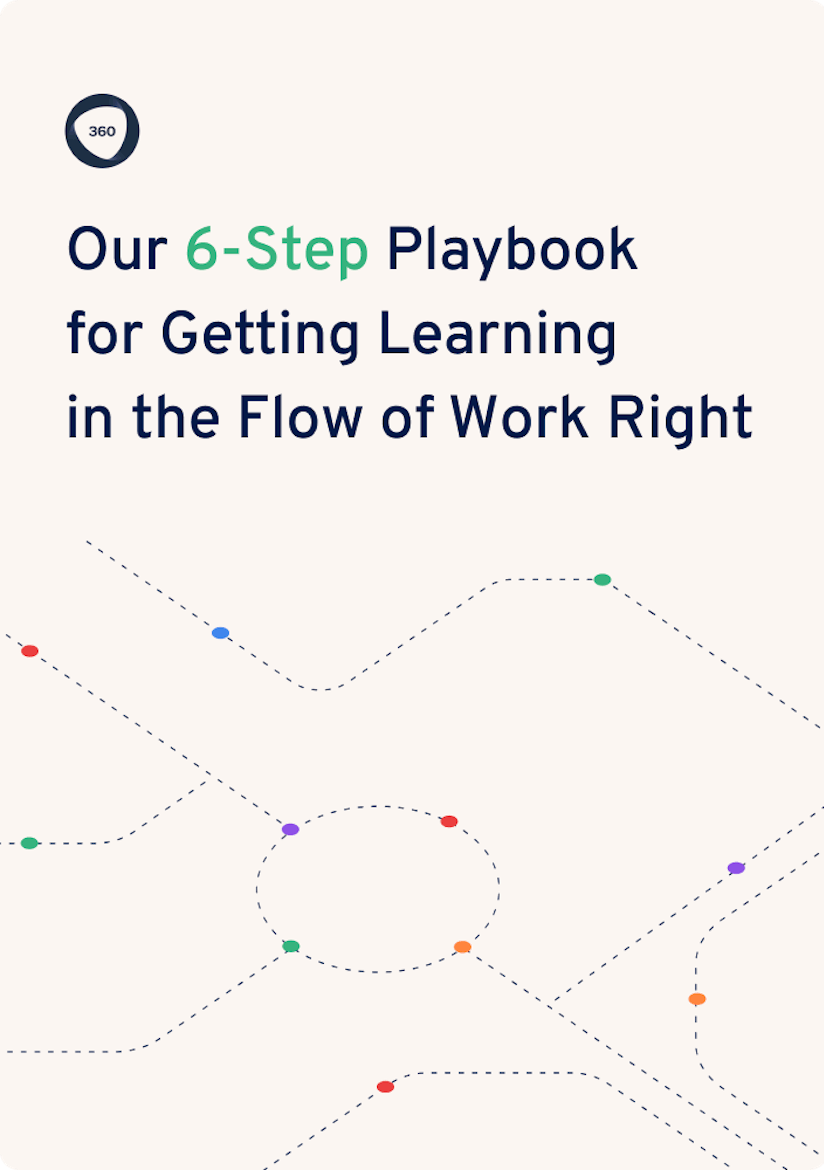
Discover the learning platform powered by collaborative learning.
A 15-minute discussion with an expert
100% tailored to your needs - with ❤️
No commitment. Free as can be.

You won’t be surprised to hear that the digital learning market has skyrocketed in the last few years and is forecast to soar for years to come.
But are eLearning, virtual workshops, or massive open online courses actually effective in helping learners at the point of need? These training formats are certainly the go-to option for the majority of L&D teams–but our new research suggests learners don’t rate these types of training.
We conducted a survey of 1,957 learners and 1,004 L&D decision-makers in the US, UK, France, and Germany, and found that globally, 7 out of 10 L&D decision makers rate digital training programs as effective (except in France where the score drops to 59%). But here’s the problem: what we’re buying isn’t necessarily what’s actually working for learners.
Read on to hear more about the types of learning learners find most effective in each country, and how L&D teams can better facilitate learning in the flow of work.
Our survey revealed a trend that highlights the biggest challenge facing L&D teams today.
Despite what our success metrics like learner engagement, completion and satisfaction rates may be telling us, L&D leaders are still struggling to measure the success of learning and development and prove exactly how we're making a demonstrable impact on employee performance.
Our results suggest this is also a challenge for learners. So, let’s dive into our survey’s insights for a closer look at each region, the types of training organizations offer, and what learners actually deem effective.
Looking for more insights on how to facilitate learning in the flow of work? Check out our six-step playbook.

By providing your contact info, you agree to receive communications from 360Learning. You can opt-out at any time. For details, refer to our Privacy Policy.
Our survey reveals that 66% of learners in the US receive online learning (such as eLearning, virtual workshops, or massive open online courses), but only 38% identify them as very effective in helping them learn to do their job–the lowest rate out of the eight training types offered.
It gets worse in the UK. 7 out of 10 learners in the UK receive online learning. However, only 29% find this training type to be very effective in learning how to do their job–again, the lowest rate out of the eight types offered. Similarly, of the 63% of French learners whose organizations recommend online learning, only 35% say that it is very effective in helping them.
But without a doubt, the country that finds online learning least effective is Germany, with only 21% of learners saying it is very effective in helping them learn how to do their job.
Without a doubt, the country that finds online learning least effective is Germany, with only 21% of learners saying it is very effective in helping them learn how to do their job.
This clearly shows that online learning, as popular as it may be in the L&D world, is not that effective in guiding and supporting learners when they need it (and in the place they need it).
Similarly to eLearning, in-house development programs are offered to employees in many organizations around the world. But often, in-house programs or training days are expensive and time consuming. So, is the investment really worth it?
According to our learners based in the UK, only 37% find in-house development programs to be very effective, even though 46% have been offered them in their organization. Similarly, in Germany, in-house development programs are rated as the second least effective method, with only 37% of learners whose organizations offer them this training (55%) saying it is very effective.
In the US, these in-house development programs seem to be doing slightly better—of the 36% who attend in-house development programs, 45% identify the training type as very effective.
These findings indicate that the heavy investment in in-house development programs isn’t necessarily worth it. Instead,L&D teams have the opportunity to divert their efforts to facilitate learning in the flow of work through alternative channels to address skill gaps.
So, which learning method was rated as most effective?
These findings indicate that the heavy investment in in-house development programs isn’t necessarily worth it. Instead,L&D teams have the opportunity to divert their efforts to facilitating learning in the flow of work through alternative channels to address skill gaps.
Learners in all countries identify “learning from peers” as an effective way to learn how to do their job. Interestingly, this type of learning provides the most support for learning in the flow of work.
At the top, learning from peers is identified as very effective by 64% of US learners who are offered these opportunities by their organization (58%). In Germany, just 42% of learners say their organization advocates learning from peers, and yet 61% say it is very effective at helping them in their role performance.
On the other hand, in the UK, just 46% of learners say they receive opportunities to learn from peers, and in France only 28% receive training through peers. Yet, 61% of UK learners find this type of training to be very effective as do 48% of French learners. Only 2% of UK learners find learning from peers somewhat ineffective, with none saying it was very ineffective.
This suggests that despite this being an effective learning method, learners are not given the opportunity to learn from their peers as much as they’d like.
Related: How We Use Peer Learning to Keep Our Company’s Competitive Edge
Next, of the 47% of US learners who receive coaching or mentoring, 61% identify this training type as very effective. We found similar results in the UK: for the 44% of UK learners offered coaching or mentoring, 59% say it is very effective in helping them learn to do their job.
Of the 47% of US learners who receive coaching or mentoring, 61% identify this training type as very effective.
More telling is that of those UK learners, no one identifies coaching or mentoring as somewhat ineffective or very ineffective. In France, only 15% of learners are offered coaching or mentoring to help them learn, but 49% say this training type is very effective. In Germany, of the 29% of learners offered coaching or mentoring, 58% identify that it is very effective.
The small percentage of organizations reporting that they offer coaching and mentoring indicates that many companies across the world are not yet taking advantage of this learning method. This suggests a significant opportunity for learning leaders to better guide and support employees as they cope with changes to their role.
Related: The What, Why, and How of Mentorship Programs at Work
Finally, our results show that instructor-led training, delivered on the job, still has a place in today’s learning environment. In the US, 58% of learners who have received instructor-led training delivered on the job described it as very effective. Learners in the UK are offered less instructor-led training than their US counterparts with only 37% being offered instructor-led training delivered on the job. Yet, 53% identify it as very effective in helping them in their role.
In Germany, 50% of those provided with instructor-led training, delivered on the job (23%) say those trainings are very effective in helping them learn how to do their job. While in France, of those 48% offered instructor-led training delivered on the job, 50% identify it as very effective.
These findings tell us there is definitely no shortage of training options for learners. Rather, the biggest challenge is for L&D programs to be more relevant and more closely distributed to the point of need to ensure effectiveness. This is supported by a recent Fosway study on digital learning realities which reported that only one in three organizations regularly support learners' on-the-job learning.
There is definitely no shortage of training options for learners. Rather, the biggest challenge is for L&D programs to be more relevant and more closely distributed to the point of need to ensure effectiveness.
Interestingly, the most effective learning methods from our survey–learning from peers, coaching and mentoring, and instructor-led training delivered on the job–all incorporate elements of learning in the flow of work. Namely, they include asking somebody questions, being shown how to do something, and getting support from a coach that builds on work currently being done.
This goes to show that L&D teams need to shift their strategy to focus on these forms of learning, prioritising them over eLearning and in-house development programs. This is reiterated in our findings, with many learners confirming “learning as I go, making the most of opportunities to speak with people and look things up for myself” as the most effective way to fit learning into their schedules.
In the UK, 63% of learners found learning as they go to be effective in fitting training into their schedules. This percentage rose to 64% of learners in the US but dropped to 47% for German learners and 37% for French learners.
So, with this new understanding of the mismatch of what L&D departments invest in versus what learners deem effective, how can L&D leaders bridge this gap to offer more practical, hands-on learning?
Our survey tells us one thing loud and clear: there’s always room for us to improve our L&D practices.
The most effective way we can achieve this is by guiding and supporting learners at their point of need to help them perform–and to make an impact.Luckily, we’ve come up with seven quick, practical recommendations to get you started!
1. Encourage peer learning: The success of your business is facilitated by encouraging a peer learning culture, enabling each team member to have a significant impact on the business by sharing what they know and helping others upskill from within.
2. Identify learning and performance needs in real-time: Organizations need to find ways to identify learning needs, ideally in the flow of work. Gathering learning needs should happen continuously in real-time, so investing in a learning needs tool is worth it.
3. Pinpoint evergreen problems: Your learners will probably encounter difficulties that hundreds if not thousands of others have already resolved. These evergreen problems may frequently pop up in onboarding or manager training programs, so this is a good place to start.
4. Leverage technology and integrations: L&D leaders should consider building business cases for integrations with business tools such as MS Teams, Salesforce, Slack, and HRIS systems to meet learners where they are and provide resources in the platforms they use daily.
5. Focus on the needs of learner cohorts: You need to truly understand the requirements and challenges within any one role. A gap analysis between the current reality and the expected performance can be a great place to start–and sometimes all this takes is the right conversation at the right time.
6. Get leadership buy-in: Start with a small pilot project that aims to improve the performance of a cohort of learners quickly. You can then use the data from this pilot to gain approval from senior leadership teams and make learning in the flow of work an ongoing priority.
7. Engage your subject-matter experts: Engaging SMEs is an excellent way to support and guide other employees and promote a culture of upskilling from within. To do this effectively, you need to enrol them in solving the problems that are recognized to be costing valuable time, money, and opportunity.
Looking for more ways to promote a culture of upskilling from within? Get in touch with one of our specialists today.
A 15-minute discussion with an expert
100% tailored to your needs - with ❤️
No commitment. Free as can be.
By providing your contact info, you agree to receive communications from 360Learning. You can opt-out at any time. For details, refer to our Privacy Policy.